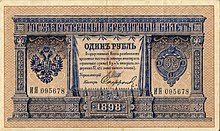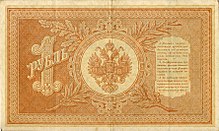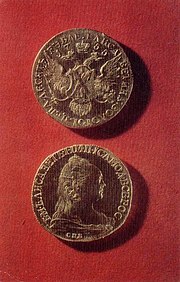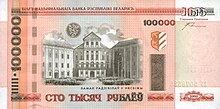ruble
The ruble ( Russian рубль Rublʹ ; abbreviation: Rbl ) is the name of the national currencies in Russia ( Russian ruble ), Belarus ( Belarusian ruble ) and Transnistria ( Transnistrian ruble ), as well as in the past in the Russian Empire , in the USSR ( Soviet ruble ) , in Latvia ( Latvian ruble ) and in Tajikistan ( Tajik ruble ). The kopeck ( копейка kopejka ) is the hundredth part of the ruble.
history
The ruble as a currency unit was first mentioned in 1321. The word Rubl originally means something like 'cut off (piece)' of a noble metal ( рубить rubit , German 'cut off' ). Accordingly, the original ruble can be assigned to the hacked silver , which occurs in various forms .
The ruble was occasionally referred to as Rublewik, Zelkowy or Karbowanez in the various Russian and Soviet parts of the country . The earliest Russian coins were usually only called S (e) rebrenik 'Silberner' or Zlatnik (in German also Slatnik) or Solotnik , similarly in German Gulden for 'Goldener'.
The city of Novgorod was the starting point for the development of coinage in Russia. For more than 1000 years, there had been strong trade relations with foreign merchants, through whom coins came to Russia. The Russians began to use silver bars as currency. From the second half of the 13th century it was common to use silver bars as a unit of currency. The weight of these bars was around 205 g, which corresponded to the old Russian weight unit, the hryvnia. In smaller commercial transactions, smaller pieces of silver were separated from the larger bars. In the 13./14. In the 19th century, coins were first minted in northwestern Russia; initially in Novgorod and Pskov , later also in Moscow , Nizhny Novgorod and Suzdal . These were the Russian cities of greater importance to trade. The local princes quickly secured the local right to mint ( coin rack ). The Moscow Grand Duke Vasily II had coins minted from around 1450 onwards with the inscription "Lords of the Whole Land of Rus". Tsar Ivan III established the sole coin shelf in Russia. In the 17th century there were still several mints in Moscow. Tsar Peter I had a new mint built in Saint Petersburg in 1724 , which was only declared the only mint in Russia in 1876.
The ruble was initially a sub-unit of the hryvnia , a currency or unit of weight, which is also eponymous for today's national currency of Ukraine (there under the Ukrainian name hryvnia ). The word Kopeke (Russian Копейка ) is derived from the fact that on the obverse of the Kopek coins, which were minted in silver for the first time since 1534 (coin reform), St. George as a rider with a spear (Russian Копьё ) in his hand - Moscow coat of arms - was pictured.
16th Century
In Tsarist Russia, the ruble was as the 16th century accounting currency to 100 kopecks or 200 Denga in use or 400 Poluschka. But it was not until the beginning of the 18th century that half-ruble and ruble coins (as large silver coins , multiple rubles as gold coins ) were minted in larger numbers. Before that, in addition to a small number of their own, even copper Rublewiki, counterstamped or overstamped German and Dutch silver talers were circulating, the Russian name of which was often "Jefimok" and was derived from the Polish language of the short name of the Joachimstaler Guldiner. Their price was between 30 and 70, mostly 64 silver kopecks.
The Russian coin history of the late Middle Ages and modern times is extraordinarily rich in bars and coins due to the vast territories. In addition, besides metal money, there were also metal tokens (for coal, beard tax, etc.), leather tokens, “birch bark banknotes” and even squirrel skins as regional currencies. In the course of Russian coin history, there was often competition between silver and copper currency coins due to a shortage of silver coins, which was then sometimes expressed in riots and unrest due to excess copper coins and the resulting inflation. From these times, multiple rubles and multiple kopecks in copper plate form from 1725/26 with a copper weight of up to more than one kilogram - similar to the Swedish Daler plate bar coins - have been passed down, which also appeared in Russian coin finds. The later copper kopecks (especially Pjatak, Pjatachok = 5 Kop.) Of the late 18th century had in some cases considerable dimensions and weights up to about 41 g, as they were the silver equivalents - similar to the English cartwheels (1 and 2 penny pieces) "Kurantgeld" should represent.
Petrine coin reform
However, the coin reforms under Tsar Peter I (the Great) in their modern coin denominations and the legal determination of the divisional coins were decisive in Russian and European monetary history . Even before 1690, the first legal and minting foundations for the currency reform that began around 1700 and extended over many years were laid, which also replaced the Cyrillic by the Arabic dates in the coinage and was not always consistent overall. The new silver ruble, minted from 1704 onwards, was adapted in rough (approx. 28 g) and fine weight (approx. 25 g) to the Western European taler coins, so that international payments were made considerably easier. In the interior of Russia from 1700 the simple older (elongated-oval) "wire" or "drip" silver kopecks and their parts - beginning with the emission of new, round copper Denga (½ Kop.), Polushka (¼ Kop .) and the very rare Polu Polushka coins (⅛ Kop.) - gradually replaced. For tactical reasons, the new round copper kopeck was only introduced a little later. This new series of coins was deliberately intended to replace the older small silver coins. However, a few silver kopecks were minted until around 1718. All of the older small silver coins were not initially taken out of circulation; However, they were no longer spent after their receipt in the state coffers and the silver they received was coined for the new ruble coins. The old silver kopecks did not lose their purchasing power, but their circulation was lost in the later years due to a lack of new minting and they were often processed into (bridal) jewelry for dowry . The copper kopeck had now been introduced by law, determined by ukase as hundredths of the ruble, and found its general acceptance in the fact that it was accepted in full in place of the earlier silver kopeck for payments to the state. It was also important that in almost all official files, contracts, laws, etc., amounts of money were only calculated in rubles to 100 kopecks.
In Germany there were also times in the middle of the 18th century when billon and copper pennies from one mint ran around at the same time at the same rate and the same minting year. As the smallest silver or billon coin for the time being , the Altyn remained as a 3-kopeck coin, which was also minted in copper from the 19th century. The last billon coin was a 5 kopeck piece - alongside the copper pjataks - which was minted in parallel until 1915.
The modern coin denomination introduced by Peter I was later adopted by many other countries, examples:
- 1 silver ruble = 10 griwenniki = 100 copper kopecks from 1700/04
- 1 silver franc = 10 decimes = 100 copper centimes from 1795
- 1 silver dollar = 10 dimes = 100 copper cents from 1792
19th century
In the course of the 19th century there were several coin reforms due to currency disruptions, which essentially reduced the fineness of silver and the size and weight of copper cut coins and also affected platinum and gold coins ( imperial ) as well as Russian-Polish and Finnish coins .
In the late 19th century until 1914, 1 silver ruble for 10 grivas or 100 kopecks contained 18 g of fine silver . Before the First World War , a new gold ruble was equivalent to 3.22½ marks , but this did not necessarily apply to the paper ruble in practical currency exchange. For paper or (old) silver rubles, only around 2.15 marks were usually exchanged in Germany before 1915.
The physical multiple gold rubles (Kurant coins ) were nominally adjusted in their gold fineness to the Latin Monetary Union from 1897 to 1914 and were actually primarily intended as trading coins for international payments . However, the stamped nominal ruble values corresponded to those of the former silver standard. Basically, however, four French francs or four Markkaa from the Grand Duchy of Finland , a former Russian province, corresponded to one gold ruble or, formally, 1 ½ old silver rubles.
For a short time in 1895 there was an intention to create a new Russian currency with the name “Rus” based on the name of the French “Franc”, but this was not realized. There are gold trial coins of 5, 10 and 15 Rusow (= 1 old imperial).
The last decisive currency reform of the Tsarist era took place under Finance Minister Sergei Witte ; he abolished the silver standard and officially introduced the gold standard in Russia in 1897. He provided that paper money (credit tickets) could be exchanged for gold coins on request. In 1902 there were other gold coins in addition to the imperial coins with a value of 100 francs = 37½ (old silver) rubles and golden 25 ruble coins in very small editions. With the outbreak of the First World War, the gold standard - as in almost all other participating countries - was effectively abolished. Interestingly, an image / print image of tsarist coins by unauthorized bodies or private individuals within Russia was prohibited.
After 1897, silver coins of one, half (Poltina or Poltinnik) and a quarter of a ruble (Polupoltina or Tschetwertak) were minted as dividing coins for internal payments as well as new half-imperials of 5 (= 13.33 gold francs) and new imperials of 10 in gold (= 26.66 gold francs); in addition, even older imperial dukates of 3 rubles and some even older imperial coins were in circulation . The gold coins were accepted domestically by at least three percent higher, i.e. with a premium . The new golden half-imperial was therefore worth at least five rubles and 15 kopecks in coins of the Russian silver "inland currency" from 1897.
20th century
In Russia before 1915 there was practically a split in the currency between domestic and foreign trade rubles, which the state did not want. There was a similar situation. B. also in the Balkan countries and Austria, where the gold crown had a secret agio compared to the "paper crown" . This splitting of the exchange rate between the gold currency versus the divorce and banknote money did not exist in the rich industrial countries like Germany, France, Great Britain or the USA. There were also small divisional coins in the form of 20, 15, 10 and 5 kopecks from a billon and 5, 3, 2, 1, ½ and ¼ kopeck coins from a bronze alloy , as well as banknotes from 1 to 500 rubles before the First World War. During the World War there were still copek banknotes and postage stamp money as substitutes for change.
The exchange rate against the mark, determined as part of the gold standard, was 0.303 per silver ruble or 32.40 M for an imperial in 1912. In 1932 there was 21.60 Reichsmarks for a Soviet Chervonetz .
As early as 1768, Catherine II founded a central bank that issued paper rubles that initially stood for copper money. The issue of paper money (banknotes) became the sole prerogative of the Russian state. At the time of the Russian Revolution , a type of paper money called " Sowsnak " was issued in large quantities , which caused hyperinflation starting as early as 1917.
Soviet Union
In the Soviet Union there was again a new, stabilized currency in the 1920s with the name "Ruble", which was partly backed by gold, silver and billon coins from 1921 to 1931 in circulation. However, it was not comparable to the previous gold standard from before 1915, since the 10 ruble gold coin ( Chervonetz ) was not intended as a trading coin for inland circulation. This now more Soviet ruble currency, however, inflated from the Second World War and was fundamentally reformed again in 1947 and 1961 in terms of appearance and price structures.
Russian Federation
After the collapse of the Soviet Union in 1991, all successor states issued their own currencies. The Latvian ruble (Rublis) was replaced by the lats in 1993 . The currency of Tajikistan was also called "ruble" until 1999; then she was replaced by the somoni .
Today (2015) there are three ruble currencies. Without the aforementioned country name, the Russian ruble is usually meant. There is also the Belarusian ruble and, since 1994, the Transnistrian ruble in the internationally unrecognized Transnistrian Moldavian Republic .
From the beginning of 2014 (when the Ukraine crisis had just started in 2014 ) to mid-November 2014, the ruble lost about a quarter of its value. The Russian central bank temporarily raised the key interest rate to 9.5 percent and bought rubles (against convertible currency reserves such as US dollars, euros, etc.), but this did not stop the ruble from falling. In November she gave up and declared that the ruble would be freely convertible in future. The foreign exchange reserves of Russia shrank during these months by 20 percent.
On December 1, 2014 for the first time more than 50 rubles had to be paid for one US dollar; one euro cost more than 65 rubles for the first time. Putin addressed the ruble exchange rate and depreciation in his annual State of the Union address on December 4, 2014. On December 16, 2014, the ruble lost a fifth of its value, although the Russian central bank had previously tried to raise its key rate by 10.5 Percent to 17 percent to stop the drop in value. Since the beginning of 2014, the ruble has lost around 60% of its external value; The fear of further devaluation drives many Russians to flee into real assets .
literature
- G. Frantz: Russian backpack dictionary. Mentor-Verlag, Berlin-Schöneberg (before 1917)
- Heinz Fengler: Lexicon Numismatics. transpress publishing house for traffic, Berlin 1988, ISBN 3-344-00220-1
- Günther Schön: World coin catalog 20th century…. Battenberg Verlag, 2003, 32nd edition, ISBN 3-89441-501-0
- Anton Seljak: On the Russian monetary system from the Kiev Empire to 1897. Web publication for the © MoneyMuseum 2002 (www.moneymuseum.com).
- Anton Seljak: The money and credit system in Russia from the Kiev Empire to 1897 - an overview of the history of currency. In: Andreas Guski, Ulrich Schmid (Hrsg.): Literature and Commerce in Russia in the 19th Century. Institutions, actors, symbols. Pano-Verlag, Zurich 2004, pp. 31–76. (Basel Studies on the Cultural History of Eastern Europe, 8, ISBN 978-3-907576-67-0 )
- Iwan Georgewitsch Spasski: The Russian coin system. A historical and numismatic outline. transpress publishing house for transport, Berlin 1983
See also
Web links
- Past and present of the ruble in Russia TODAY
- The coins of Russia and the USSR
- Coins of Russia (English)
- See under "Coin (Russian)"
- Photos of old and modern ruble coins
Remarks
- ↑ See: List of exchange rates (gold standard)
- ^ Carl Otto: The house secretary. Berlin 1913, p. 485, 3rd cover page
- ↑ From A – Z: Das Konversationslexikon; Berlin 1932, Col. 417 ff.
- ↑ The economic consequences of the Ukraine crisis for Russia ... ( Memento from November 24, 2014 in the Internet Archive ) (November 21, 2014)
- ↑ (Loss since the beginning of the year against the euro about 30 percent; against the US dollar over 33 percent) FAZ.net December 1, 2014: Russian ruble crashes into the basement
- ↑ spiegel.de: Currency crisis in Russia: The crash of the ruble can leave Putin cold
- ↑ FAZ.net December 3, 2014: Eliminating the crisis - Russian President Putin is trying to gain something positive from the dramatic decline of the ruble - and promises good times. The evidence, however, suggests growing nervousness
- ↑ Presidential Address to the Federal Assembly , kremlin.ru, accessed June 22, 2018.
- ↑ FAZ.net: Payday in Russia
- ↑ FAZ: net: Russia's central bank increases key interest rate to 17 percent
- ↑ FAZ.net December 16, 2014: Quickly get rid of the ruble
- ↑ spiegel.de: Ruble crash: Russia crash hits Germany













